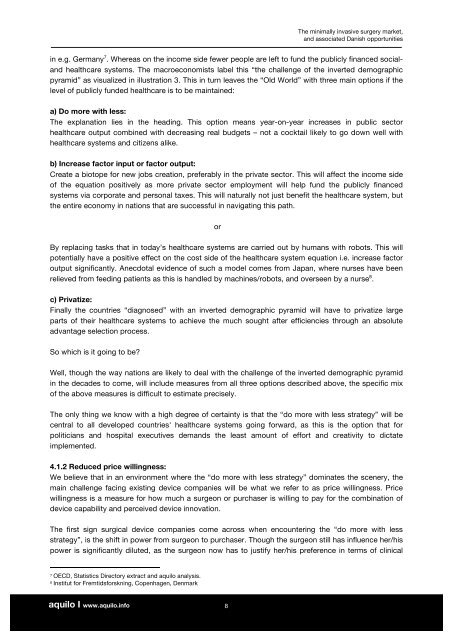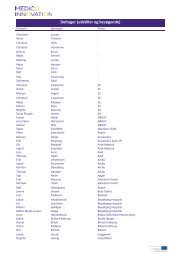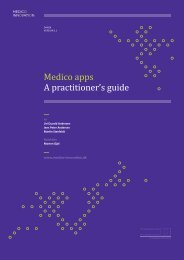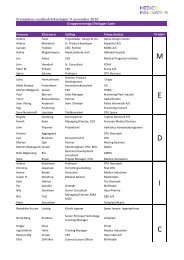The minimally invasive surgery market, and associated Danish ...
The minimally invasive surgery market, and associated Danish ...
The minimally invasive surgery market, and associated Danish ...
You also want an ePaper? Increase the reach of your titles
YUMPU automatically turns print PDFs into web optimized ePapers that Google loves.
aquilo I www.aquilo.info<br />
8<br />
<strong>The</strong> <strong>minimally</strong> <strong>invasive</strong> <strong>surgery</strong> <strong>market</strong>,<br />
<strong>and</strong> <strong>associated</strong> <strong>Danish</strong> opportunities<br />
in e.g. Germany 7 . Whereas on the income side fewer people are left to fund the publicly financed social-<br />
<strong>and</strong> healthcare systems. <strong>The</strong> macroeconomists label this “the challenge of the inverted demographic<br />
pyramid” as visualized in illustration 3. This in turn leaves the “Old World” with three main options if the<br />
level of publicly funded healthcare is to be maintained:<br />
a) Do more with less:<br />
<strong>The</strong> explanation lies in the heading. This option means year-on-year increases in public sector<br />
healthcare output combined with decreasing real budgets – not a cocktail likely to go down well with<br />
healthcare systems <strong>and</strong> citizens alike.<br />
b) Increase factor input or factor output:<br />
Create a biotope for new jobs creation, preferably in the private sector. This will affect the income side<br />
of the equation positively as more private sector employment will help fund the publicly financed<br />
systems via corporate <strong>and</strong> personal taxes. This will naturally not just benefit the healthcare system, but<br />
the entire economy in nations that are successful in navigating this path.<br />
or<br />
By replacing tasks that in today’s healthcare systems are carried out by humans with robots. This will<br />
potentially have a positive effect on the cost side of the healthcare system equation i.e. increase factor<br />
output significantly. Anecdotal evidence of such a model comes from Japan, where nurses have been<br />
relieved from feeding patients as this is h<strong>and</strong>led by machines/robots, <strong>and</strong> overseen by a nurse 8 .<br />
c) Privatize:<br />
Finally the countries “diagnosed” with an inverted demographic pyramid will have to privatize large<br />
parts of their healthcare systems to achieve the much sought after efficiencies through an absolute<br />
advantage selection process.<br />
So which is it going to be?<br />
Well, though the way nations are likely to deal with the challenge of the inverted demographic pyramid<br />
in the decades to come, will include measures from all three options described above, the specific mix<br />
of the above measures is difficult to estimate precisely.<br />
<strong>The</strong> only thing we know with a high degree of certainty is that the “do more with less strategy” will be<br />
central to all developed countries' healthcare systems going forward, as this is the option that for<br />
politicians <strong>and</strong> hospital executives dem<strong>and</strong>s the least amount of effort <strong>and</strong> creativity to dictate<br />
implemented.<br />
4.1.2 Reduced price willingness:<br />
We believe that in an environment where the “do more with less strategy” dominates the scenery, the<br />
main challenge facing existing device companies will be what we refer to as price willingness. Price<br />
willingness is a measure for how much a surgeon or purchaser is willing to pay for the combination of<br />
device capability <strong>and</strong> perceived device innovation.<br />
<strong>The</strong> first sign surgical device companies come across when encountering the “do more with less<br />
strategy”, is the shift in power from surgeon to purchaser. Though the surgeon still has influence her/his<br />
power is significantly diluted, as the surgeon now has to justify her/his preference in terms of clinical<br />
7 OECD, Statistics Directory extract <strong>and</strong> aquilo analysis.<br />
8 Institut for Fremtidsforskning, Copenhagen, Denmark







